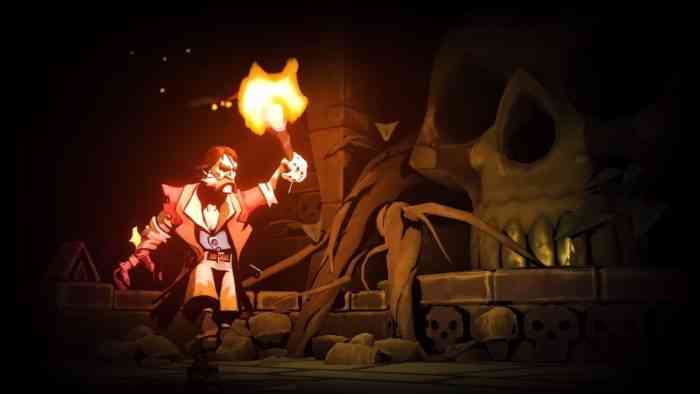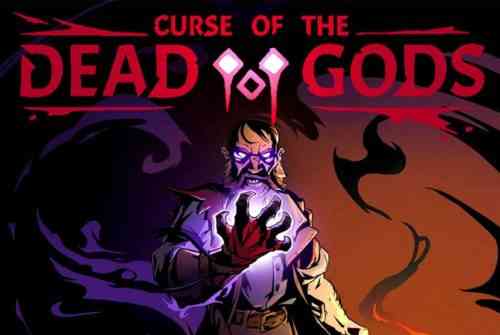Curse of the Dead Gods Preview
Curse of the Dead Gods is a self-proclaimed demanding Rogue-lite title but it’s more akin to what I imagine a Diablo Rogue-lite would look like. The looting system is very similar, despite some slight differences in the UI. There are a number of things to loot as you melt the darkness away with a torch, lighting braziers and cobwebs along the way. Relics will alter your gameplay similar to ability points or stat boosters in other games, increasing things such as critical strike and maximum health. Some relics that can be purchased are a combination of relics, costing a lot of gold or health but giving a permanent stat increase for your run. These provide flexibility in gameplay and are finely tuned to properly compliment other gear in the game.
Although there are no classes to choose from, you can choose to play the game to your liking in some ways. Do you like heavy attacks that knock enemies back and interrupt their spell casting? Heavy weapons will keep them at a distance. Do you prefer to stay a long distance away from your enemies and pick them off one by one? Some range weapons are the most powerful damage dealers in the game. Are you a rogue like rogue-lite fan who likes to rogue while they rogue and deal swift dagger strikes that poison the demons that lurk in the darkness? This was easily my favorite option of the bunch and it was just a combination of deadly, poisonous daggers and a speed increase relic. Combining relics with your weapons is essential as you progress through the area map, especially with corruption slowly making the gameplay more difficult.
That Moment You Forget You’re Not Playing Hardcore Diablo
Corruption will give you interesting, gameplay changing debuffs that make things more interesting as you move along from stage to stage. There’s one known as Volatile Remains turn the fallen enemies you slay into exploding corpses, another is called Blinding Greed which makes gold disappear after a short time. Some of these include benefits such as Blinding Greed also increasing the amount of gold that litters a stage. My personal favorite debuff was called Raging Temple as it doubled the amount of traps I had to worry about, but gave me that many more traps to kite enemies into. The biggest annoyance to me was a corruption debuff called Shadowflame which could stack with Shadow Word to make enemies nearly invisible throughout the temple. Relics are so important to counter these game changing curses and allow you to continue exploring the area map.

Blessings are a fun feature in Curse of the Dead Gods that gives you a buff of some variety for each playthrough, transferring from one to the other. Unlike Relics, weapons, etc. these carry over each time you die and you can unlock new ones with spirits which are looted on nearly every stage. The blessings are basically relics as they provide stat boosts and ultimately you can stack three of them together to make the game easier. Curse of the Dead Gods is by no means an easy game but Blessings keep me customizing my gameplay before entering the temple, giving me different ways to play as I unlock more with spirits.
Darkness Is Not Your Friends but the Unknown Can Be Very Kind
Enemies vary in design but the usual suspects are at play here, there are ranged attackers, melee attackers and hybrids. Dodging is important in all cases, with each enemy having the same colourful flash of light as they’re about to attack. This flash can be confusing in some cases because traps share the same colourful prompt. So you may at times go to dodge a trap but really you were supposed to dodge an enemy attack as it was the most imminent danger. Traps hidden in the shadows add to the complexity in strategizing your way through the area map. Bosses known as champions cap off each area map and they provide the greatest challenge in the game. This is where the enemy design is ramped up, with Killiz’Puzah, the Blood Hunter being the first champion and his summoned hell hounds capable of overwhelming the best geared adventurer in a pinch with health. There are chests that include varying degrees of loot and they’re scattered around enemy infested rooms. The chests vary in design as well, providing a different look from the room before and usually the one after as well.

Each stage of the area map covers a theme such as relics, gold, stat increases, weapons and my personal favorite, the unknown. It’s important to study an area map ahead of time as each life features a unique one and knowing your path can be the difference between life and death in Curse of the Dead Gods. Haven levels are places to heal in exchange for more corruption which will curse and debuff you the more you heal. The less damage you take, the less corruption you take and the less corruption you absorb, the less difficult the game is as you progress. Similar to the area maps, each level is different like the dungeons of Diablo so there’s no way to fully scout out your path through the game. Just like any great rogue-lite, this provides the constant feeling of unknown, especially on unknown stages.
With an extensive roadmap planned for this early access title, the developers of Curse of the Dead Gods intend to constantly add to and evolve the game as people play it. There are more weapons, relics, enemies, game modes, mechanics, etc. on the way and I’m looking forward to each stage of this games development.
***PC code provided by publisher***

